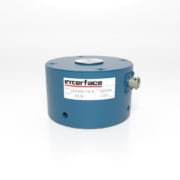Force Measurement Solutions Support Innovation in Manufacturing
 The manufacturing world is enormous, covering multiple industries and applications for force measurement. The manufacturing sector comprises factories and plants that use machines and equipment to build parts and final goods.
The manufacturing world is enormous, covering multiple industries and applications for force measurement. The manufacturing sector comprises factories and plants that use machines and equipment to build parts and final goods.
With an estimated 21 million manufacturing companies worldwide, the industry is also becoming more advanced and regulated, with technologies such as AI and automation influencing manufacturing processes to drive efficiency and safety.
There are various types of manufacturing, from repetitive, continuous, batch, job shop, and discrete. All employ tools, machines, and equipment used through multiple processes. Manufacturers use Interface load cells, torque transducers, multi-axis sensors, and instrumentation to improve products and processes, meet performance requirements, automate machines, protect workers, and test designs. Force measurement supports innovation in manufacturing.
With advancements and process improvements, testing and measuring are primary to every manufacturing stage. It begins with product planning through machine building. Moving to assembly and monitoring production lines, sensors are at work through final distribution. Manufacturing engineers use Interface devices to test assembly line equipment, design and operate robotics, improve machinery, and operate tools like presses.
Manufacturing equipment and processes that utilize Interface load cells and torque transducers:
- Conveyor Belts
- Robotics and Cobots
- Torque Wrenches
- Tension Testing Machines
- Weighing Systems and Scales
- Heavy Machinery
- Transportation and Moving Equipment
- Mixers
- Packaging Equipment
- Sorting and Picking Devices
- Material and Stress Testing Labs
- Fatigue and Compression Testing Equip
How Manufacturers Use Interface Products
- Research and Development: The measurement data from transducers provides a valuable roadmap to improving the design of products and processes.
- Testing: Every product undergoes rigorous testing before hitting the line. Interface force measurement devices are essential for this manufacturing phase to validate the use, lifecycle, and materials.
- Machine and Tool Building: Machine builders use Interface sensor technologies to weigh raw materials, components, and finished products to ensure they meet the required specifications. Force measurement devices are important in measuring applied force by equipment and processes that help control product quality and prevent accidents. Machine builders frequently use load cells to monitor loads over time to detect and prevent potential machine problems. Read more about why Machine Builders Choose Interface.
- Quality Assurance: Interface products are used to measure the weight of manufactured products to ensure that they meet specifications. This is important for consumer goods, pharmaceuticals, medical devices, and other products where precise weight measurement is critical for safety and effectiveness.
- Automation: Force measurement products are valuable in automation. As robotics, cobots, tools, and machinery are designed to automate tasks and processes in manufacturing, load cells like our multi-axis sensors provide valuable analysis data through all phases of automation.
- Retrofitting Existing Equipment with Sensors: Manufacturers require modern tools and equipment to meet growing demands. Interface products are used to retrofit machines and update tools with sensor-based technologies, such as replacing machine pins with load pins that measure loading and lifting in real-time.
- Safety and Regulation: Sensors prevent accidents by detecting dangerous conditions in the manufacturing industry. Using measurement systems for alarms, alerts, and monitoring of equipment and tools is critical in manufacturing plants.
- Process Control: Manufacturing operations monitor the force or weight of materials in a facility to control the process and ensure that products are made to the correct specifications.
- Productivity and Equipment Maintenance: Using Interface products to monitor the condition of equipment and detect potential problems before they cause downtime helps to prevent costly breakdowns and production delays.
Our depth of force measurement expertise and experience enable us to innovate, engineer, and produce the world’s most accurate, reliable, and quality sensor technology for manufacturers worldwide. This can be seen through some specific application examples in which Interface solutions have been involved. We have included a few of these examples below.
Robotic Grinding and Polishing During Production
Robotic grinding and polishing are commonly used in manufacturing. Robots or cobots are programmed to grind and polish on varied materials and surfaces. A force measurement system must be implemented to monitor and control the force exerted on the grinding workpiece. Interface’s Model 6A40A 6-Axis Load Cell can be installed between the flange and the grinding tool. When connected to the BX8-HD44 Data Acquisition, the customer can receive force and torque measurements when connected to their control system using BlueDAQ software. The 6A40-6 Axis Load Cell measures all forces and torques (Fx, Fʏ, Fz, Mx, Mʏ, Mz), and our BXB-HD44 Data Acquisition logs, displays and graphs these measurements while sending scaled analog output signals for these axes to the robot’s control system. Manufacturing: Robotic Grinding and Polishing application.
Manufacturing Feed Roller System
A customer has a feed roller system that monitors the forces of both ends of the rollers to maintain a constant straight feed. They preferred a wireless system. Interface suggested installing two PBLC Pillow Block Load Cells at both ends of the bottom roller to measure the applied forces. The forces were measured when connected to the WTS-AM-1E Wireless Strain Bridge Transmitter Module. The data was then transmitted wirelessly to the WTS-BS-6 Wireless Telemetry Dongle Base Station and the WTS-BS-1-HA Wireless Handheld Display for multiple transmitters, where data was displayed, graphed, and logged on the customer’s PC or laptop. The PBLC Pillow Block Load Cells installed at the bottom roller were able to measure and monitor the forces to maintain the straight feed by the rollers. Manufacturing: Feed Roller System app note.
Press Load Monitoring for Material Testing
Press forming is a method to deform different materials. For instance, materials such as steel can be bent, stretched, or formed into shapes. A force measurement solution is required to monitor the forces the press-forming machine applies. This ensures quality control and traceability during the production process. Interface recommends installing the 1000 High Capacity Fatigue-Rated LowProfile™ Load Cell for large press forming machines. When the material is placed under the punch plate to form a shape, the force applied is measured by the Interface 1000 Series Load Cell. The captured force results are sent to the INF-USB3 Universal Serial Bus Single Channel PC Interface Module, where results can be graphed and logged on the customer’s PC using the provided software. Interface’s force measurement products and instrumentation accurately monitored and logged the force results of the press force machine, ensuring zero-error production performance.
Interface began designing and manufacturing load cells and other force measurement equipment in 1968. These precision load cells are commonly found in factories worldwide in testing equipment, scales, machines, and production line devices. Load cells help bring life to older machines with accurate measurements while in use, ultimately improving maintenance and worker safety in manufacturing.
Our force measurement products are versatile and valuable tools for manufacturers. Our sensor solutions improve the quality, safety, and efficiency of products and the equipment and tools used to make them.
Manufacturing Solutions Brochure








